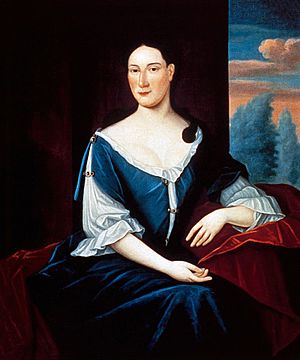Abigail Franks facts for kids
Quick facts for kids
Abigail Franks
|
|
|---|---|

Portrait of Abigail Franks, c. 1735
|
|
| Born |
Bilhah Abigail Levy
c. 1696 |
| Died | 1756 (aged 59–60) |
| Known for | Letters describing political, social, and religious life in colonial New York |
| Spouse(s) | Jacob Franks |
| Children | 9 |
| Parents |
|
Bilhah Abigail Levy Franks (around 1696–1756) was an English-born Ashkenazi Jewish woman. She spent most of her life in New York City, which was then part of British America. Abigail married a successful merchant and raised nine children.
She was known for her many letters to her oldest son, Naphtali. These letters, written between 1733 and 1748, give us a peek into life in New York in the 1700s. They also show how Jewish families sometimes blended into the wider society. Abigail's letters are important because they tell us about the politics, social life, and religious customs of the time.
Contents
Early Life of Abigail Franks
Bilhah Abigail Levy was born in London, England. Her parents were Moses Levy, a German-Jewish merchant, and Richea Asher. Abigail had four brothers.
In the early 1700s, her family moved to New York City. Her father became a very rich and respected merchant. He had business connections across the Atlantic Ocean. Abigail received a good education for her time. When she was 11, her mother passed away. Her father later remarried and had eight more children.
Family Life and Social Connections
In 1712, when she was 16, Abigail married Jacob Franks (1688–1769). He was a businessman also born in London. Abigail and Jacob had nine children between 1715 and 1742. Sadly, two of their children died when they were young. They were married for 44 years.
Jewish Life in Colonial New York
At that time, there were very few Jewish families in Colonial New York. Only about 50 families lived there. Even so, Abigail kept a traditional Jewish home. This meant she followed strict rules for the Sabbath (the day of rest). She also observed Jewish holidays and kept a kosher kitchen. All her children learned about Hebrew and Jewish prayers. The Franks family were members of Congregation Shearith Israel, a synagogue. Jacob even served as the synagogue's president in 1730.
Socializing with Christian Neighbors
The Franks family was also very active in the wider Christian society. Jacob became very wealthy through various businesses. The Franks were seen as one of the most important families in New York during the Colonial era. They lived near the East River, close to many important Protestant leaders.
Jacob and his father-in-law, Moses Levy, were among 11 Jewish people who helped pay for a steeple for the First Trinity Church. This steeple helped guide ships coming into the harbor. Abigail had many close Christian friends. She even spent summer holidays with them.
Children and Marriage
Around 1732, Abigail and Jacob started sending their sons to England. They wanted their children to learn about the family business. Their sons Naphtali and Moses became successful in England. Their son David also did well after moving to Philadelphia.
It was hard to find Jewish partners for marriage in colonial America. The Franks family was also comfortable with Christian society. Because of this, two of Abigail's children married people who were not Jewish. Abigail stopped talking to her oldest daughter, Phila. This happened after Phila secretly married Oliver De Lancey, a Christian. Phila later became a Christian. However, Jacob accepted the marriage.
David, another son, married the daughter of one of Abigail's Christian friends. Naphtali and Moses married Jewish cousins in England. But all of their children later married outside the Jewish faith. By the end of the 1700s, Abigail had no Jewish descendants.
Abigail's Letters
Abigail wrote many letters to her oldest son, Naphtali, who lived in England. Thirty-four of her letters still exist today. There is also one letter from Jacob and two from David. These letters were written between 1733 and 1748.
The letters talk about many things. They include family news, local politics, and Abigail's thoughts on Judaism in New York. Abigail believed it was important to follow Jewish traditions. She wanted her children to marry within the Jewish faith. However, she also had some criticisms of Jewish practices at the time. She wished for more modern ideas in the religion. She also described the lives of other Jewish American women.
Abigail enjoyed reading classic books and magazines. She often used quotes from famous English poets like John Dryden and Alexander Pope in her letters.
Franks-Levy Family Portraits
Abigail mentioned several times in her letters that portraits were being painted. The Franks and Levy families had portraits made of themselves. They also exchanged portraits with family members in London.
There is a group of seven portraits that are believed to show three generations of the family. These portraits were given to the American Jewish Historical Society in 1951. They are now kept at the Crystal Bridges Museum of American Art in Bentonville, Arkansas. These portraits are thought to be the oldest surviving paintings of Jewish people from colonial America. They are also the oldest family portraits in American painting.
The portraits are believed to show Moses Levy, Grace Mears Levy, Jacob Franks, Abigail Franks, Naphtali Franks, and two other children. They were likely painted in the 1720s and 1730s by Gerardus Duyckinck. The paintings show the family dressed like English noble people. There is nothing in the portraits that clearly shows they are Jewish.
Images for kids


